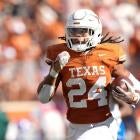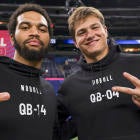Whether you crave wide receivers or view them as a necessary evil in Fantasy, you must be aware of the options you have to procure them on Draft Day. The first factor is knowing how many wide receivers you must start, how many teams are in your league and whether or not receptions count. These are pretty big in determining a roster building game plan. Those factors will serve as the backbone of any draft strategy you'll take with the position.
A 10-team PPR league that starts two wideouts (even with a flex) is cake, but a 14-team, non-PPR, three-receiver league will make you sweat a little more. Obviously, the more receivers that must be started and the more Fantasy managers there are, the sooner you should prioritize taking receivers. PPR scoring creates value for receivers who otherwise might struggle to have, say, 900 yards and five scores.
How aggressive should you be to take a receiver in Round 1? For most, it'll come down to the breaking point of when you don't trust the remaining running backs. Can't trust Clyde Edwards-Helaire? Think the Miles Sanders hype is out of control? Not buying a Bengals running back? Wherever your cut-off for elite running backs is, that's where your gravitation toward sure-fire studs like Michael Thomas or Davante Adams begins.
Round 2 is kind of the same. Again, you'll know which running backs you'll feel good about picking, and if they're not there, or if you don't want Travis Kelce, Patrick Mahomes or Lamar Jackson, you'll default to receiver. Such a move would be easy if one of the top-six receivers were involved, but it's a little tougher once you get past Chris Godwin, who seems like a safe bet for close to 100 receptions again.
The next few rounds are the sweet spot for wide receiver value — players with top-10 potential who could be found as late as 60th overall. It is highly recommended Fantasy managers take advantage of this group. If you have three receivers from the first five or six rounds, you're doing just fine.
But even if you dip into Round 7 to land a second or third receiver, it's okay. There are a lot of breakout candidates (Darius Slayton, Diontae Johnson) as well as ol' reliables (Jarvis Landry, Brandin Cooks). They're great for Fantasy benches but good enough to use as a Flex or No. 3 option, be it to start the year or in the middle of the season.
More tiers and strategies:
- QB Tiers 5.0 | QB Draft Day Strategies
- RB Tiers 5.0 | RB Draft Day Strategies
- WR Tiers 5.0 | WR Draft Day Strategies
- TE Tiers 5.0 | TE Draft Day Strategies
On targets and touchdowns
Remember to consider the volume of targets a receiver gets and/or the number of touchdowns a receiver could predictably get. If a receiver averages 7.0 targets per game, that's 112 for the season. Of the 25 receivers with 1,000 yards last season, 21 had at least 112 targets. Also, only two receivers had over 112 targets and did not have 1,000 yards — Adams (997 yards in 12 games) and Jamison Crowder (833 yards). Of course touchdown production leads to good Fantasy production, and any receiver with a chance to score eight in a season can be considered a useful Fantasy choice. That's obvious. If you are looking at a receiver who you don't think can average 7.0 targets per week or score eight times over the season, you probably shouldn't draft him unless it's a late-round pick.
Looking for wideouts late
Before you take a wide receiver with a late-round choice, consider some basics. Is the receiver the No. 2 (or maybe even No. 1?!) option in the offense? Does he have a solid quarterback? Does the offense favor the pass more than the run? There are receivers who check off all these boxes and can be found in the final four tiers. It's never a bad idea to take one of them. Some favorites of mine: Preston Williams, Jalen Reagor/DeSean Jackson, CeeDee Lamb, Anthony Miller, Henry Ruggs, Steven Sims, Breshad Perriman and Parris Campbell. They're all worth a patient three-week tryout on a Fantasy bench to start the year.
Drop the rookies?
It's true that the 2020 rookie crop of wide receivers is very talented. There are players who should be impactful in Fantasy Football for a long time. But only a few will be able to transition from college to the pros with just a handful of training camp practices and no offseason program work whatsoever. The Coronavirus pandemic has hampered their collective development.
Pedigree should be a factor, as should opportunity. Reagor, Lamb, Jerry Jeudy and Ruggs all seem to be on the fast track toward every-down work in their offenses. Reagor has the best quarterback of them all, Lamb and Jeudy are considered the most NFL-ready and Ruggs is the fastest. It's dangerous to take more than one on a Fantasy roster, but one or all could come through with some success in 2020.
It would be awesome if these rookies had a typical offseason, training camp and preseason. But they haven't, so take serious caution with them all.
The bottom line
- Elite-level wide receivers may be in short supply, but there's a bunch of No. 2/No. 1 upside wide receivers, so don't feel pressured to take a stud wideout early on.
- If you want to play it safe, draft as many receivers from the first four tiers as you need to cover your starting lineup requirements.
- You shouldn't have to rush to draft wide receivers unless your league is deep, your rosters are deep or your scoring is not PPR.
- If you can't picture a receiver scoring eight times or averaging 7.5 targets per game, don't draft him … unless you're in Round 9-plus and just taking some fliers.
- And remember, no matter what round you're in, there's a receiver there you should be comfortable with.
More tiers and strategies:
- QB Tiers 5.0 | QB Draft Day Strategies
- RB Tiers 5.0 | RB Draft Day Strategies
- WR Tiers 5.0 | WR Draft Day Strategies
- TE Tiers 5.0 | TE Draft Day Strategies
So what Fantasy football sleepers should you snatch in your draft? And which WR1 candidate can you wait on until late? Visit SportsLine now to get cheat sheets from the model that was all over Derrick Henry's huge season, and find out.























